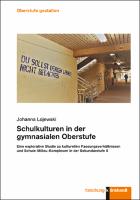Schulkulturen in der gymnasialen Oberstufe
Eine explorative Studie zu kulturellen Passungsverhältnissen und Schule-Milieu-Komplexen in der Sekundarstufe II
| dc.contributor.author | Lojewski, Johanna | |
| dc.date.accessioned | 2023-06-20T11:04:45Z | |
| dc.date.available | 2023-06-20T11:04:45Z | |
| dc.date.issued | 2023 | |
| dc.identifier.uri | https://library.oapen.org/handle/20.500.12657/63615 | |
| dc.description.abstract | Based on repeated empirical evidence that the structure and organization of the German education system systematically ensure unequal educational and life chances, this work takes a look at the upper secondary level (“gymnasiale Oberstufe”) as the central awarding body for the “Abitur” (A-Level), which has gained in quantitative importance over the last 60 years and at the same time has been exposed to considerable structural and contentual transformations. These developments, as well as the accompanying institutional and social diversification of upper secondary schools, will be examined from the perspective of the works on education by Bourdieu and Passeron, especially the “Theory of Symbolic Violence” (1973). More recent theoretical perspectives and connections are also discussed, which differentiate and complement their rather global assumptions. | en_US |
| dc.language | German | en_US |
| dc.relation.ispartofseries | Oberstufe gestalten | en_US |
| dc.subject.classification | thema EDItEUR::J Society and Social Sciences::JN Education::JNL Schools and pre-schools::JNLC Secondary schools | en_US |
| dc.subject.other | Gymnasiale Oberstufe; Schulkultur; Sekundarstufe II; Schulumwelt; Gymnasium; Bildungssoziologie; Heterogenität; Reform; Schulgeschichte; Bourdieu, Pierre; 20. Jahrhundert; 21. Jahrhundert; Quantitative Forschung; Empirische Forschung; Explorative Studie; Sekundäranalyse; Dissertationsschrift; Deutschland | en_US |
| dc.title | Schulkulturen in der gymnasialen Oberstufe | en_US |
| dc.title.alternative | Eine explorative Studie zu kulturellen Passungsverhältnissen und Schule-Milieu-Komplexen in der Sekundarstufe II | en_US |
| dc.type | book | |
| oapen.abstract.otherlanguage | Ausgehend von wiederholten empirischen Belegen, dass Struktur und Organisation des deutschen Bildungswesens systematisch für ungleiche Bildungs- und Lebenschancen sorgen, nimmt die vorliegende Arbeit die gymnasiale Oberstufe als zentrale Vergabestelle für das Abitur in den Blick, die in den letzten 60 Jahren quantitativ an Bedeutung gewonnen hat und zugleich erheblichen strukturellen und inhaltlichen Transformationen ausgesetzt war. Diese Entwicklungen sowie die damit einhergehende institutionelle und soziale Diversifizierung der gymnasialen Oberstufe werden aus Perspektive der bildungssoziologischen Arbeiten von Bourdieu und Passeron, insbesondere der „Theorie der symbolischen Gewalt“ (1973), betrachtet. Dabei werden auch neuere theoretische Perspektiven und Anschlüsse erörtert, die die deren relativ pauschalen Annahmen ausdifferenzieren und ergänzen. | en_US |
| oapen.identifier.doi | 10.35468/6016 | en_US |
| oapen.relation.isPublishedBy | 9a084ee3-3f86-4be2-81d6-89c9fbc5f173 | en_US |
| oapen.relation.isFundedBy | 631ac483-8bae-460f-9987-c3f4e4b98bb5 | en_US |
| oapen.relation.isFundedBy | 9205ce14-724e-4a85-a419-56de0143036a | en_US |
| oapen.relation.isbn | 9783781525757 | en_US |
| oapen.pages | 265 | en_US |
| oapen.place.publication | Bad Heilbrunn | en_US |

